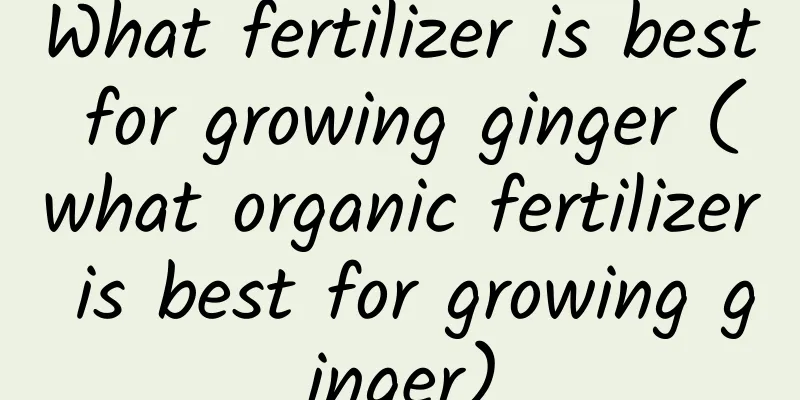What fertilizer is best for growing ginger (what organic fertilizer is best for growing ginger)

|
Ginger is a common condiment and also has certain medicinal properties in traditional Chinese medicine. During the planting process, ginger is different from many crops. Because it is reproduced asexually, special attention needs to be paid to the use of fertilizers for ginger. So how to apply fertilizer to ensure good growth and yield of ginger? Fertilizer requirements for gingerThe growth of ginger has certain requirements for soil and fertilizer. It is best to cultivate it in soil with deep soil layer, loose soil, rich organic matter, good ventilation and drainage. In terms of fertilizers, every 1,000 kg of ginger produced requires 6.34 kg of nitrogen, 1.31 kg of phosphorus, and 11.17 kg of potassium. In addition, trace elements such as calcium, magnesium, and boron are also needed. From the amount of fertilizer required, it can be seen that ginger requires more potassium and nitrogen elements, and relatively less phosphorus. Base fertilizer is also importantGinger is a fleshy root crop, and its edible and medicinal parts are the roots, so more investment should be made in root nourishment and root protection during the fertilization process, which requires that ginger planting should focus on base fertilizer. Adequate base fertilizer can provide long-term nutrients for ginger growth, and adding microbial agents can improve the soil environment and reduce the occurrence of soil-borne diseases. Therefore, it is recommended to apply sufficient microbial agents and organic fertilizers before planting ginger. If farm organic fertilizers are used, they must be well decomposed. There are three common base fertilizers for planting ginger: 1. Livestock and poultry manureThis type of organic fertilizer is a relatively good organic fertilizer with a relatively high fertilizer efficiency. Livestock and poultry manure cannot be directly applied to the fields. Because it contains a variety of salts, antibiotic residues, pathogenic bacteria, insect eggs, etc., livestock and poultry manure is very common in rural areas, but in small quantities. If you want to get more livestock and poultry manure, it is best to go to the farm to collect it. In rural areas, livestock and poultry manure is often mixed with crop straw for composting. Before applying such organic fertilizer in the fields, it must be composted at high temperature in advance. Fully decomposed livestock and poultry manure is a high-quality organic fertilizer. Some crop straw can be used as feed for cattle, sheep, etc. Such crop straw can be returned to the fields through the stomach, which can significantly improve the fertilizer efficiency. Fully decomposed livestock and poultry manure has high fertilizer efficiency. Generally, applying about 1,000 kilograms of dried pure manure per acre of land will have a very good effect. 2. Soil and fertilizerCrop straw, after crushing, can be mixed with livestock and poultry manure for composting, and superphosphate can be added to it and mixed with straw, livestock and poultry manure, organic fertilizer, leaves, etc. for composting. The sources of raw materials for local fertilizers are very wide. After they are fully decomposed, more than 5 cubic meters can be applied per acre of land without causing adverse phenomena such as burning seedlings. Moreover, after the crop straw is decomposed, it has a very good loosening effect on the soil, which makes the soil breathable and more conducive to the extension of the root system. Planting ginger in such soil will make the underground rhizomes of ginger large and thick, and the yield will be high. 3. Cake fertilizerCommon examples include soybean cake, rapeseed cake, peanut cake, etc., which are the by-products obtained by pressing oil. This type of cake fertilizer is rich in nutrients, especially protein, which is of high quality. If conditions permit, soybean cake can be fed to livestock and poultry, which not only improves the economic benefits of livestock and poultry, but also has a good fertilizer effect. Moreover, cake fertilizers are rich in organic matter. If you use cake fertilizers as base fertilizer continuously every year, you will get a very obvious yield-increasing effect. Multiple topdressingGinger needs to undergo multiple topdressings during the ginger stage, namely the seedling stage, the growth stage and the swelling stage. The growth is slow in the seedling stage and the demand for fertilizer is relatively small. A small amount of topdressing can be applied, mainly balanced water-soluble fertilizers and high-potassium water-soluble fertilizers. During the growth period, the intensity of fertilization should be gradually increased. Especially around the beginning of autumn, ginger enters a rapid growth period, and the amount of fertilizer required during this period is relatively large. High-potassium water-soluble fertilizer and microbial agents can be applied. The swelling period is the time when ginger needs the most fertilizer. At this time, in addition to high-potassium water-soluble fertilizer, attention should also be paid to supplementing medium and trace elements to ensure better growth. |
Recommend
How many kilograms of lotus root can be produced per mu?
Lotus root yield per mu Lotus root is a common ve...
How to grow peacock feathers so that they bloom
Peacock feather flower blooming time Peacock feat...
Why do gardenias drop their buds?
1. The soil in the pot is too wet It prefers a mo...
If you put this flower at home, the temperature will drop by 10℃ immediately. You won’t want to go out in the summer!
Areca palm Areca palm is also called yellow cocon...
What does rosemary do?
1. Helps you sleep Rosemary flowers and seeds can...
How to plant sand ginger
1. Planting time Sand ginger is usually sown in s...
How many days does it take for water spinach to germinate?
Water spinach , also known as water spinach and w...
Why is the loquat tree dropping leaves?
1. Excessive watering 1. Reason: If you water the...
How to prune apple trees and when and how to do it
Apple tree pruning time Apple trees grow relative...
Calla Lily Fresh Cut Flower Production
How to make fresh cut flowers of Calla Lily Mater...
Tips for fertilizing flowers
1. Seasonal fertilization When fertilizing flower...
Cultivation methods and precautions of Oncidium
Soil requirements Oncidium prefers a relatively d...
What vegetables are suitable for planting in September in the south?
The temperature in the south starts to get cooler...
How to grow baby's breath in summer
1. Breeding conditions 1. Soil: It likes alkaline...
How to raise Milan in summer
1. Breeding environment 1. Temperature: Milan lik...









